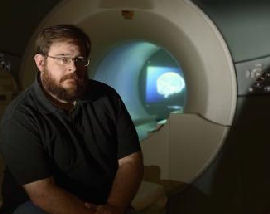20 September 2013
Your brain digitally tuned for clarity of thought
by Will Parker
 Intriguing research from Virginia Tech suggests that with advances in neurofeedback techniques, the signal-to-noise ratio of the brain activity underlying our thoughts can be "remastered."
Intriguing research from Virginia Tech suggests that with advances in neurofeedback techniques, the signal-to-noise ratio of the brain activity underlying our thoughts can be "remastered."
Detailing his work in the Proceedings of the National Academy of Sciences, Stephen LaConte (pictured) explained how his team were using real-time functional magnetic resonance imaging (fMRI) to eavesdrop on previously undetectable mental activities and feed back this data to the subject.
"Our brains control overt actions that allow us to interact directly with our environments, whether by swinging an arm or singing an aria," LaConte said. "Covert mental activities, on the other hand - such as visual imagery, inner language, or recollections of the past - can't be observed by others and don't necessarily translate into action in the outside world."
In the new study, LaConte used whole-brain, classifier-based real-time fMRI to understand the neural underpinnings of brain-computer interface control. The research team asked two dozen subjects to control a visual interface by silently counting numbers at fast and slow rates. For half the tasks, the subjects were told to use their thoughts to control the movement of the needle on the device they were observing; for the other tasks, they simply watched the needle.
The scientists discovered a feedback effect that LaConte said he had long suspected existed but had found elusive: the subjects who were in control of the needle achieved a better whole-brain signal-to-noise ratio than those who simply watched the needle move.
"When the subjects were performing the counting task without feedback, they did a pretty good job," LaConte said. "But when they were doing it with feedback, we saw increases in the signal-to-noise ratio of the entire brain. This improved clarity could mean that the signal was sharpening, the noise was dropping, or both. I suspect the brain was becoming less noisy, allowing the subject to concentrate on the task at hand."
The scientists also found that the act of controlling the computer-brain interface led to an increased classification accuracy, which corresponded with improvements in the whole-brain signal-to-noise ratio.
This enhanced signal-to-noise ratio, LaConte says, carries implications for brain rehabilitation. "When people undergoing real-time brain scans get feedback on their own brain activity patterns, they can devise ways to exert greater control of their mental processes. This, in turn, gives them the opportunity to aid in their own healing."
The research carries implications for people whose brains have been damaged, such as through traumatic injury or stroke, setting the stage for capturing covert brain activity and creating better computer interfaces that can help people retrain their own brains. "Ultimately, we want to use this effect to find better ways to treat brain injuries and psychiatric and neurological disorders," said LaConte.
Related:
Discuss this article in our forum
Brain-training claims questioned
Who'd have thunk it? Scientists reveal how overthinking handicaps human performance
MRI scans predict pop music success
Thought-controlled robotic arm demonstrated
Source: Virginia Tech
